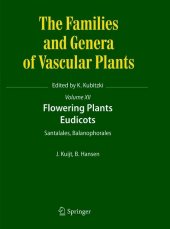 Neuerscheinungen 2019Stand: 2020-02-01 |
Schnellsuche
ISBN/Stichwort/Autor
|
Herderstraße 10
10625 Berlin
Tel.: 030 315 714 16
Fax 030 315 714 14
info@buchspektrum.de |

Bertel Hansen (deceased), Klaus Kubitzki, Job Kuijt
(Beteiligte)
Flowering Plants. Eudicots
Santalales, Balanophorales
Softcover reprint of the original 1st ed. 2015. 2019. x, 213 S. 82 SW-Abb. 260 mm
Verlag/Jahr: SPRINGER, BERLIN; SPRINGER INTERNATIONAL PUBLISHING 2019
ISBN: 3-319-79167-2 (3319791672)
Neue ISBN: 978-3-319-79167-8 (9783319791678)
Preis und Lieferzeit: Bitte klicken
In the present volume taxonomic treatments including descriptions of and keys to the families and genera for the orders Santalales and Balanophorales are offered, the former group here comprising 12 families with 162 genera and about 2100 species, and the latter with the single family Balanophoraceae composed of 16 genera and about 42 species. The contentious family classification of Santalales has been thoroughly revised against the background of previous classifications as well as available structural and molecular evidence, and also the classification of Balanophoraceae has been carefully updated.
Santalales are predominantly hemiparasites connected with either the branches or the roots of other green land plants, whereas Balanophoraceae are holoparasites that form terrestrial tubers attached to the roots of woody hosts. In both orders, parasitism has led to considerable reductions of the vegetative and reproductive organs and detailed descriptions are given on the initiation of ramal and terrestrial parasitism in Santalales and the haustorial connection and tissue continuity between host and parasite in both groups. The dramatic reduction of the vegetative body in Balanophoraceae, which may lack all vegetative organs typically found in green land plants, has promoted studies in the field of developmental morphology. Thus, the volume not only provides an overview of the diversity of the plant groups treated therein, but also points to the interesting biological peculiarities that have evolved in connection with their singular lifestyle.
Santalales
Historical Survey
Morphology and Anatomy
Stem
Leaf
Roots-See section on Parasitism
Inflorescences
Flowers
Pollen, Including Fossil Pollen
Chromosome Numbers and Embryology
Fruits, Seeds and Seedlings
Germination
Biological and Structural Aspects of Parasitism
Recognition of Parasitism in Santalales
Haustoria in Santalales
Tissue Continuity with the Host
Uptake of Water and Nutrients from the Host
Epicortical Roots
Vegetative Reproduction in Santalales
Host Preferences
Hyperparasitism
Amphiphagy?
Facultative Parasitism?
Semi- vs. Holoparasitism
Chemosystematics (by K. Kubitzki)
Santalales in Human Affairs and Conservation
Family Classification
Summary of Changes
Santalalean Families as Presently Accepted
Sequence of Families
A Note on the Term "Mistletoe"
Key to the Families of Santalales
Aptandraceae
Coulaceae
Eremolepidaceae
Loranthaceae
Genera of the New World
Genera of Africa and Madagascar
Genera of Australia and New Zealand
Genera of Eurasia
Misodendraceae
Octoknemaceae
Olacaceae
Opiliaceae
Santalaceae
Schoepfiaceae
Viscaceae
Ximeniaceae
Balanophorales
Balanophoraceae
Glossary
Index


